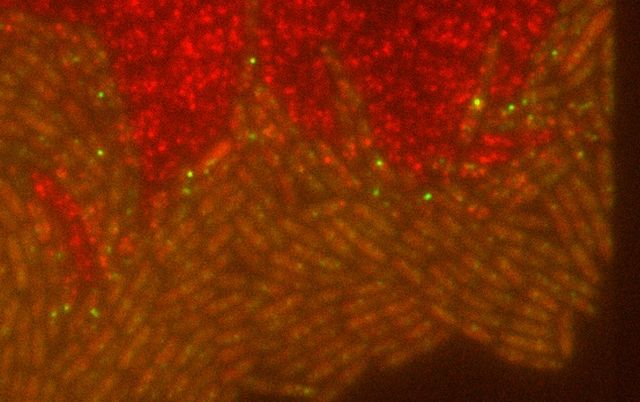Jones lab

Our research seeks to connect the molecular details of intracellular protein kinetics to larger-scale phenomena such as gene expression and mobile genetic element spread. To do so we use techniques such as time-lapse fluorescence microscopy to monitor the population dynamics of conjugative plasmid spread in bacterial populations, and mRNA FISH to observe gene expression at the single-cell level.
Popular Science Presentation
The fact that traits such as height, hair color, or even personality are often passed from parents to their offspring was appreciated long before modern understandings of genes and DNA. But what if you could pass the gene for a particular hair color to a stranger simply by shaking their hand? While impossible in humans, such "horizontal transfer" of genes to unrelated individuals is commonplace in bacteria.
One of the most common ways for this to take place is through so-called conjugative plasmids. Plasmids are short pieces of circular DNA that can replicate themselves inside a bacterial host cell and frequently contain antibiotic resistance genes. Some plasmids – conjugative plasmids – have the ability to transfer or “conjugate” themselves to neighboring bacteria by essentially injecting themselves through a syringe-like structure. This ability to transmit themselves both “vertically” (from one bacterium to its daughters) and “horizontally” (to neighboring bacteria via conjugation) has been instrumental in enabling the rapid spread of antibiotic resistance genes, increasingly recognized as a major public health threat [1].
At the same time, most bacteria contain a variety of systems aimed at defending themselves against invading foreign DNA such as conjugative plasmids and viruses. CRISPR-Cas is one such system particularly noteworthy for its ability to “learn” the DNA sequences of previously encountered invaders, thus granting the bacterium partial or full immunity to the virus or conjugative plasmid upon subsequent encounters (similarly to how prior infection or vaccination can prime our immune system to respond to particular viruses). Specifically, CRISPR-Cas systems recognize the DNA sequence of invading DNA and cut the DNA strand, leading to its destruction.
But if conjugative plasmids are so great at making bacteria resistant to antibiotics, why would bacteria bother defending against them in the first place? While plasmids can confer benefits to their bacterial hosts in the form of antibiotic resistance, they also incur a cost in terms of the resources required for their replication and spread. Thus from the bacteriums perspective these plasmids can at times be harmful. On the other hand CRISPR-Cas and other immune systems also come with a cost: allocating cellular resources to defense means that fewer resources are available to cells for their own growth and development, just as a nation with excessive defence spending will have fewer resources available for health and social welfare.
It is thus the balance of the costs and benefits of immunity vs. the costs and benefits of harboring the plasmid that determine whether and how quickly a conjugative plasmid will spread throughout the population. Our work seeks to quantify and understand these factors using techniques such as fluorescence microscopy to directly observe how conjugative plasmids spread throughout a population, as well as monitoring their destruction by CRISPR-Cas systems. In this way we hope to better understand how antibiotic resistance genes spread through populations of bacteria, and perhaps even learn how to harness defense systems to slow the spread.
[1] Murray, C.J., Ikuta, K.S., Sharara, F., Swetschinski, L., Aguilar, G.R., Gray, A., Han, C., Bisignano, C., Rao, P., Wool, E., et al. (2022). Global burden of bacterial antimicrobial resistance in 2019: a systematic analysis. The Lancet.
Research projects
CRISPR immunity and the spread of mobile genetic elements
Mobile genetic elements such as phage and conjugative plasmids play a key role in enabling microbes to adapt to new ecological niches. Unfortunately, one such niche is human-created environments (such as farms and hospitals) characterized by high antibiotic use. In this project we seek to understand the dynamics of conjugative plasmid spread at a single-cell level, as well as how this spread is affected by CRISPR-Cas systems. To do so we label the various molecular players with fluorescent tags, enabling us to use time-lapse fluorescence microscopy to directly observe individual conjugation and interference events. Ultimately, we seek to connect recent work elucidating the dynamics of relevant players such as CRISPR effector proteins to the larger-scale population dynamics of mobile genetic element spread.
Group members
Publications
Time-resolved imaging-based CRISPRi screening
Part of Nature Methods, p. 86-92, 2020
Measuring cis-regulatory energetics in living cells using allelic manifolds
Part of eLIFE, 2018
- DOI for Measuring cis-regulatory energetics in living cells using allelic manifolds
- Download full text (pdf) of Measuring cis-regulatory energetics in living cells using allelic manifolds
Part of Proceedings of the National Academy of Sciences of the United States of America, 2018
Kinetics of dCas9 Target Search in Escherichia Coli
Part of Biophysical Journal, 2017
Kinetics of dCas9 target search in Escherichia coli
Part of Science, p. 1420-1423, 2017

